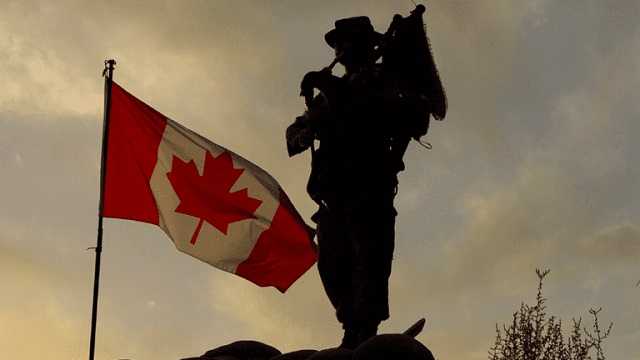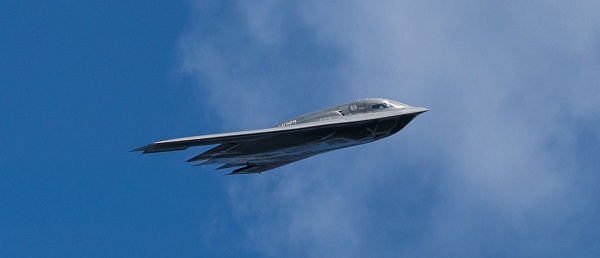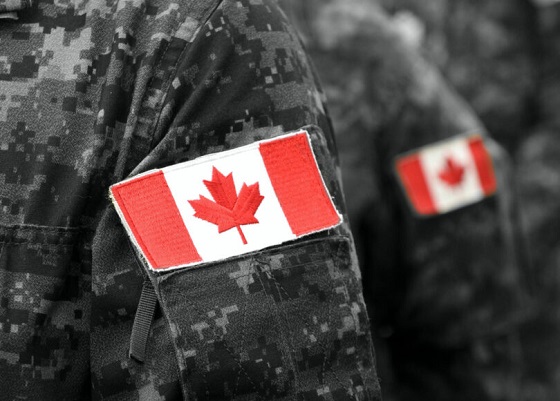armed forces
We can do more than just remember. Let’s actually support those who serve.

From the MacDonald Laurier Institute
By Richard Shimooka
Many veterans transition to civilian life feeling rudderless and alone and missing necessary support structures
Remembrance Day is the one time in the year that the lives and issues facing soldiers and veterans intrude into the public consciousness in any substantial way. Yet the image that is evoked is heavily based on the Second World War and Korean War experiences—conflicts that have directly affected a dwindling generation of individuals. Meanwhile, the lives and challenges of our current generation of soldiers and veterans are very different and not well understood.
The reality can be grim. A 2014 Statistics Canada Study showed that 48 percent of Canadian Armed Forces (CAF) members will experience a major mental health condition or alcoholic abuse in their lifetime. While currently serving personnel do not see an increase in suicide rates relative to the population, the suicide rate for male veterans after their release is 50 percent higher than the general population, 200 percent higher for female veterans, and 250 percent higher for male veterans under the age of 25.
These sorts of statistics, backed up by anecdotal evidence, cast a dour light on their overall military experience. I think the problem can be distilled down to a series of lies that exist at the heart of Canada’s relationship with its military members.
The government asks members of the Canadian Armed Forces for unlimited liability, and in return, CAF members trust the government to provide them with the tools to do their jobs and the policies and systems to take care of them in their most vulnerable times. This social contract is at the core of military service—and the government is essentially lying when it claims that it is upholding its side of the agreement. And due to that failure, soldiers often suffer a lifetime moral injury as a result.
First, it is fairly evident that military personnel are not being provided the resources required to carry out their jobs properly. In procurement, for example, considerations such as “social license” and “industrial and technical benefits” edge out the needs of soldiers, often leaving them with inadequate capabilities to achieve their missions. It often leaves soldiers across the CAF feeling disrespected despite their ongoing sacrifices,
But this is only one part of the issue. The CAF and Veterans Affairs Canada’s (VAC) personnel policies towards current and former military members are simply inadequate. It takes a certain type of person to join the CAF and remain in service for any length of time. In most cases, those very skills, knowledge, and work habits that are in demand within the CAF today are also highly sought after in the Canadian workforce—and often at significantly higher pay scales than what is offered within the military. CAF members are often shuttled to remote bases in places like Cold Lake, Shilo, or Oromucto, then sent on months-long deployments abroad. The continued outsourcing of key military benefits, such as housing and movement grants, and the inability to have a credible grievance mechanism, have produced a military experience that varies wildly from soldier to soldier in an already complex and stressful job.
Furthermore, spouses and families often bear the brunt of the challenging military lifestyle. Many of Canada’s bases are located far from major metropoles. Remember, with the CAF requiring more highly trained soldiers, it is likely that their spouses also have similar educational and employment skill sets—ones that cannot be met in remote military towns. While official statistics are scarce, there is some evidence suggesting that divorce rates for current and former military members are significantly higher than in the general population.
Most destructive is just how inept the government’s personnel management policies are. First, systems for overseeing current members and veterans employ antiquated data management systems, which creates barriers to accessing services.
This brings us to a broader point: the relationship between the bureaucracy and soldiers and veterans is not a harmonious one. At best it can be described as adversarial. At every step, current and former military members have to prove their eligibility for programs to skeptical public servants and/or contractors. They must become records packrats as they never know when a key piece of information will become critical to proving the validity of their claim.
The focus of the “system” seems like it is less there to assist individuals in need and more there to prevent the almost minuscule possibility that fraud may occur. This lack of trust manifests itself in so many different ways, altering health benefits for dependents, even for the widows/widowers of soldiers and veterans, cost of living rebates, and more.
Furthermore, even the programs and policy alternatives that are available are deliberately left unpublicized, perhaps in a misguided effort to keep departmental costs down. It is often through word of mouth or online communities that the existence of these policies (and how to access them) is disseminated amongst veterans or serving members. This illustrates the reality of the situation and the lie that the government is doing its best to help current and former military members. Rather, it actively works against them in some important instances.
Despite all of this, it can be surprising that so many members choose to remain in service to their country. Certainly, the higher calling that comes with public service is an important motivator: they strive hard to uphold their side of the social contract.
Another issue, though, is that there is also a “big lie” that current soldiers and veterans tell themselves to make it through: that everything is alright.
I can’t tell you how many allied personnel will rave about the relentless resourcefulness of Canadian military personnel. This is colloquially referred to as the “can-do” attitude. A culture of essentially getting things done regardless of the risk.
But there is more to it than that. Certainly, there was an element of masculinity that has inhibited soldiers from seeking help. Furthermore, the fears exist among personnel that acknowledging mental defects could impact their future service progression. The failure to repeal or mitigate Paragraph 98 (c) of the National Defence Act, which criminalizes self-harm, is one of several policies that stigmatizes those who suffer mental health episodes.
At its root, the broader CAF culture explains some of the relationship dynamics between superiors and subordinates. If soldiers are conditioned to not express how they feel, it makes it difficult for them to then turn around and be effective at dealing with the issues within their organization. We can laud the perceptive leaders who intrinsically understand the corrosive effect these issues have on their subordinates’ lives and try to rectify them, but it is a challenge for many in command positions because they have been conditioned within this culture to avoid these questions.
Moreover, there’s the pervasive reality that the CAF requires a unique culture to undertake its primary task of providing for the security and defence of Canada and its interests. As I mentioned in a previous column, the CAF’s culture is the glue that holds the force together in extremely difficult operations. Yet that focus on conformity can also result in destructive effects on some members’ psyche.
Given all of these considerations, it is not at all surprising that soldiers essentially lie to themselves about their situation in order to get through each day. Fortunately, they have a clear sense of purpose while serving their country; often, however, veterans do not. Many transition to civilian life feeling rudderless and alone, without the support structures that allowed them to operate at high levels while in the service. Even worse, some veterans are deliberately made to feel the burden of a system that was created to treat service-related injuries.
In the end, usurping these lies is not insurmountable, but it will require dedicated time, effort, and resources to overcome them. In short, robust political support across all parties has been lacking for many decades. Overhauling the relationship will have practical benefits that will go far beyond just meeting the needs of soldiers and their families. It will go a long way in addressing the retention and potentially the recruitment crisis that has deeply affected the CAF for the past decade.
But aside from that, it is just the morally right thing to do, and that really should be the guiding position for any policy in this area. Beyond just taking the time to remember their sacrifices for one day once a year, providing tangible improvements to the lives and working conditions of soldiers and veterans would be a meaningful way to thank them for their service.
Richard Shimooka is a Hub contributing writer and a senior fellow at the Macdonald-Laurier Institute who writes on defence policy.
armed forces
Global Military Industrial Complex Has Never Had It So Good, New Report Finds


From the Daily Caller News Foundation
The global war business scored record revenues in 2024 amid multiple protracted proxy conflicts across the world, according to a new industry analysis released on Monday.
The top 100 arms manufacturers in the world raked in $679 billion in revenue in 2024, up 5.9% from the year prior, according to a new Stockholm International Peace Research Institute (SIPRI) study. The figure marks the highest ever revenue for manufacturers recorded by SIPRI as the group credits major conflicts for supplying the large appetite for arms around the world.
“The rise in the total arms revenues of the Top 100 in 2024 was mostly due to overall increases in the arms revenues of companies based in Europe and the United States,” SIPRI said in their report. “There were year-on-year increases in all the geographical areas covered by the ranking apart from Asia and Oceania, which saw a slight decrease, largely as a result of a notable drop in the total arms revenues of Chinese companies.”
Notably, Chinese arms manufacturers saw a large drop in reported revenues, declining 10% from 2023 to 2024, according to SIPRI. Just off China’s shores, Japan’s arms industry saw the largest single year-over-year increase in revenue of all regions measured, jumping 40% from 2023 to 2024.
American companies dominate the top of the list, which measures individual companies’ revenue, with Lockheed Martin taking the top spot with $64,650,000,000 of arms revenue in 2024, according to the report. Raytheon Technologies, Northrop Grumman and BAE Systems follow shortly after in revenue,
The Czechoslovak Group recorded the single largest jump in year-on-year revenue from 2023 to 2024, increasing its haul by 193%, according to SIPRI. The increase is largely driven by their crucial role in supplying arms and ammunition to Ukraine.
The Pentagon contracted one of the group’s subsidiaries in August to build a new ammo plant in the U.S. to replenish artillery shell stockpiles drained by U.S. aid to Ukraine.
“In 2024 the growing demand for military equipment around the world, primarily linked to rising geopolitical tensions, accelerated the increase in total Top 100 arms revenues seen in 2023,” the report reads. “More than three quarters of companies in the Top 100 (77 companies) increased their arms revenues in 2024, with 42 reporting at least double-digit percentage growth.”
armed forces
2025 Federal Budget: Veterans Are Bleeding for This Budget

How the 2025 Federal Budget Demands More From Those Who’ve Already Given Everything
I’ve lived the word sacrifice.
Not the political kind that comes in speeches and press releases the real kind. The kind Mark Carney wouldn’t know if it slapped him in the face. The kind that costs sleep, sanity, blood. I’ve watched friends trade comfort for duty, and I’ve watched some of them leave in body bags while the rest of us carried the weight of their absence. So when the Prime Minister stood up this year and told Canadians the new budget would “require sacrifice,” I felt that familiar tightening in the gut the one every veteran knows. You brace for impact. You hope the pain lands in a place that makes sense.
It didn’t.
Kelsi Sheren is a reader-supported publication.
To receive new posts and support my work, consider becoming a free or paid subscriber.
Six months into Mark Carney’s limp imitation of leadership, it’s painfully clear who’s actually paying the bill. The 2025 budget somehow managing to bleed the country dry while still projecting a $78-billion deficit shields the political class, funnels money toward his network of insiders, and then quietly hacks away at the one department that should be sacrosanct: Veterans Affairs Canada.
If there’s one group that’s earned the right to be spared from government-imposed scarcity, it’s the people who carried this country’s flag into danger. Veterans don’t “symbolize” sacrifice they embody it on the daily And when Ottawa tightens the belt on VAC, the consequences aren’t abstract. They’re brutal and direct, causing nothing but more death and destruction. But Mark Carney doesn’t lose sleep over veterans killing themselves.
Punishment disguised as budgeting for a veteran means the difference between keeping a roof or sleeping in a truck. Punishment disguised as budgeting means PTSD left untreated until it turns a human being into another suicide statistic. Punishment disguised as budgeting means a veteran choosing between groceries and medication because some number-shuffler in Ottawa wants to pretend they’re being “responsible.”
This isn’t fiscal restraint it’s political betrayal wrapped in government stationery. Ottawa sells it as hard choices, but the hardness always falls on the backs of the same people: the ones who already paid more than their share, the ones who can’t afford another hit. Carney and his cabinet won’t feel a thing. Not one missed meal. Not one sleepless night. Not one flashback.
But the men and women who already paid in flesh? They’re the ones being told to give more.
That’s not sacrifice.
That’s abandonment dressed up as fiscal policy.
And Canadians need to recognize it for what it is a government that demands loyalty while refusing to give any in return. The fine print in the government’s own documents reveals what the slogans won’t.
Over the next two years, VAC plans to cut $2.227 billion from its “Benefits, Services and Support” programs. [2] Broader “savings initiatives” reach $4.4 billion over four years, much of it through reductions to the medical-cannabis program that thousands of veterans rely on to manage chronic pain and PTSD. [3] Independent analysts estimate yearly losses of roughly $900 million once the cuts are fully implemented. [4]
To put that in perspective: no other department is seeing reductions on this scale. Not Defence, not Infrastructure, not the Prime Minister’s Office thats for damn sure. Only the people who’ve already paid their debt to this country are being asked to give again.
The government’s line is tidy: “We’re not cutting services we’re modernizing. Artificial Intelligence will streamline processing and improve efficiency.”
That sounds fine until you read the departmental notes. The “modernization” translates into fewer human case managers, longer waits, and narrower eligibility. It’s austerity dressed up as innovation. I’ve coached veterans through the system. They don’t need algorithms; they need advocates who understand trauma, identity loss, and the grind of reintegration. They need empathy, not automation.
This isn’t abstract accounting. Behind every dollar is a life on the edge, the human cost and toll is very real.
- Homelessness: Veterans make up a disproportionate number of Canada’s homeless population. Cutting benefits only deepens that crisis.
- Mental Health: Parliament’s ongoing study on veteran suicide shows rising rates of despair linked to delays and denials in VAC services. [5] Knowing MAID for mental illness alone in 2027 will take out a significant amount of us.
- Food Insecurity: A 2024 VAC survey found nearly one in four veterans reported struggling to afford basic groceries. That’s before these cuts.
We talk about “service” like it ends with deployment. It doesn’t. Service continues in how a nation cares for those who carried its battles, and this doesn’t include the cannabis cut to medication or the fight’s we have to fight when they tell us our injuries are “not service related”
The insult is magnified by the timing. These cuts were announced just days before November 11 Remembrance Day, when Canadians bow their heads and say, “We will remember them.”
Apparently, the government remembered to draft the talking points but forgot the meaning behind them, not a single one of the liberal government should have been allowed to show their faces to veteran’s or at a ceremony. They’re nothing but liars, grifters and traitors to this nation. Yes I’m talking about Jill McKnight and Mark Carney.
The budget still runs the second-largest deficit in Canadian history. [6]
Veteran cuts don’t fix that. They barely dent it. What they do is let the government say it’s “finding efficiencies” while avoiding the real structural overspending that created the problem in the first place. When a government chooses to protect its pet projects and insider contracts while pulling support from veterans, that’s not fiscal discipline it’s moral cowardice. The worst part is that This isn’t an isolated move. It fits a six-month pattern: large, attention-grabbing announcements about “reform,” followed by fine print that concentrates power and shifts burden downward. Veterans just happen to be the first visible casualty.
The same budget expands spending in other politically convenient areas green-transition subsidies, digital-governance infrastructure, and administration while the people who once embodied service are told to tighten their belts.
As a combat veteran, I know what it’s like to come home and realize that the fight didn’t end overseas it just changed terrain. We fought for freedom abroad only to watch bureaucratic neglect wage a quieter war here at home. Veterans don’t ask for privilege. They ask for respect, for competence, for follow-through on the promises this country made when it sent them into harm’s way.
Here’s what really needs to change, the liberal government has to go, thats step one. Restore VAC funding immediately. Any “savings” plan that touches benefits, services, or support should be scrapped. End the AI façade. Efficiency can’t replace empathy. Keep human case workers who understand the veteran experience. Audit and transparency. Publish a detailed breakdown of where VAC funds are cut and who approved it. Canadians deserve to see the receipts. National accountability. Every MP who voted for this budget should face veterans in their constituency and explain it, face-to-face.
Budgets are moral documents. They show what a country values. By slashing VAC while running record deficits, this government declared that veterans are expendable line items, not national obligations. The Prime Minister promised “shared sacrifice.” But the only people truly sacrificing are the ones who already gave more than most Canadians ever will.
Sacrifice isn’t about spreadsheets; it’s about service. It’s what every veteran understood when they raised their right hand. This government’s brand of sacrifice asking wounded soldiers to pay for political mismanagement isn’t austerity. It’s abandonment.
Canada owes its veterans more than a wreath once a year. It owes them respect written into every budget, not erased from it.
KELSI SHEREN
Footnotes
[1] The Guardian, “Canada’s 2025 Federal Budget Adds Tens of Billions to Deficit as Carney Spends to Dampen Tariffs Effect,” Nov 5 2025.
[2] True North Wire, “Liberal Budget to Cut $4.23 Billion from Veterans Affairs,” Nov 2025.
[3] StratCann, “Budget 2025 Includes Goal of Saving $4.4 Billion in Medical Cannabis Benefits,” Nov 2025.
[4] Canadian Centre for Policy Alternatives, “Where Will the Federal Government Cut to Pay for Military Spending and Tax Cuts?” Nov 2025.
[5] House of Commons Standing Committee on Veterans Affairs, “Study on Veteran Suicide and Sanctuary Trauma,” ongoing 2025.
[6] CBC News, “Federal Budget 2025 Deficit Second Largest in Canadian History,” Nov 2025.
Kelsi Sheren is a reader-supported publication.
To receive new posts and support my work, consider becoming a free or paid subscriber.
-

 COVID-192 days ago
COVID-192 days agoUniversity of Colorado will pay $10 million to staff, students for trying to force them to take COVID shots
-

 Bruce Dowbiggin2 days ago
Bruce Dowbiggin2 days agoIntegration Or Indignation: Whose Strategy Worked Best Against Trump?
-

 espionage2 days ago
espionage2 days agoWestern Campuses Help Build China’s Digital Dragnet With U.S. Tax Funds, Study Warns
-

 Bruce Dowbiggin2 days ago
Bruce Dowbiggin2 days agoWayne Gretzky’s Terrible, Awful Week.. And Soccer/ Football.
-

 Agriculture2 days ago
Agriculture2 days agoCanada’s air quality among the best in the world
-

 Business1 day ago
Business1 day agoCanada invests $34 million in Chinese drones now considered to be ‘high security risks’
-

 Health2 days ago
Health2 days agoCDC Vaccine Panel Votes to End Universal Hep B Vaccine for Newborns
-

 Business2 days ago
Business2 days agoThe EU Insists Its X Fine Isn’t About Censorship. Here’s Why It Is.







